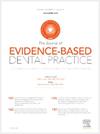AWAKE BRUXISM PREVALENCE ACROSS POPULATIONS: A SYSTEMATIC REVIEW AND META-ANALYSIS
IF 4
4区 医学
Q1 DENTISTRY, ORAL SURGERY & MEDICINE
引用次数: 0
Abstract
Objectives
Bruxism significantly affects oral health, with consequences such as tooth wear and restoration failures. Additionally, it is linked to various risk factors and co-occurring disorders. Unlike sleep bruxism, awake bruxism (AB) is more strongly associated with psychosocial factors. This review aimed to evaluate the prevalence of AB in the general population and specific subpopulations.
Methods
The review followed PRISMA guidelines and was registered in PROSPERO (CRD42023398868). A literature search in PubMed, Scopus, and Web of Science until April 8, 2025 identified studies that fulfilled the inclusion criteria of reporting AB prevalence in adult populations. Risk of bias was assessed with Joanna Briggs Institute Prevalence Critical Appraisal Tool and a random-effects meta-analysis determined prevalence in various subpopulations.
Results
The search yielded 8,818 records, with 5,408 abstracts screened after duplicate removal. Of these, 4,473 were excluded. Full-text assessment led to the exclusion of 843 articles that did not meet inclusion criteria. A hand search identified 5 additional studies. Ultimately, 94 studies involving 49,163 individuals were included, with 66 studies (39,823 individuals) analyzed in the meta-analysis. In the general population, self-reported “possible” AB had a mean prevalence of 25.9% (95% CI 22.2-29.9), and clinically based “probable” AB 16.0% (95% CI 10.0-24.5). Prevalence was significantly higher in specific subpopulations, such as individuals with temporomandibular disorders (50.0%, 95% CI 41.1-58.9) and systemic conditions (40.1%, 95% CI 31.4-49.5). Risk of bias was mainly related to assessment of AB.
Conclusions
The variability between subpopulations highlights the importance of considering patient-specific factors and a targeted clinical approach in AB management.
醒磨牙症在人群中的患病率:系统回顾和荟萃分析
目的磨牙严重影响口腔健康,导致牙齿磨损和修复失败。此外,它还与各种危险因素和共同发生的疾病有关。与睡眠磨牙症不同,清醒磨牙症(AB)与社会心理因素的关系更密切。本综述旨在评估AB在普通人群和特定亚人群中的患病率。方法该综述遵循PRISMA指南,在PROSPERO注册(CRD42023398868)。在PubMed、Scopus和Web of Science进行文献检索,直到2025年4月8日,确定了符合报告成人AB患病率纳入标准的研究。采用乔安娜布里格斯研究所流行关键评估工具评估偏倚风险,并采用随机效应荟萃分析确定不同亚群的流行程度。结果共检索到8818条记录,剔除重复后筛选出5408条摘要。其中,4473人被排除在外。全文评估导致843篇不符合纳入标准的文章被排除。手工搜索确定了另外5项研究。最终,纳入了94项研究,涉及49,163人,其中66项研究(39,823人)在荟萃分析中进行了分析。在一般人群中,自我报告的“可能”AB的平均患病率为25.9% (95% CI为22.2-29.9),而基于临床的“可能”AB的平均患病率为16.0% (95% CI为10.0-24.5)。在特定亚群中患病率明显更高,例如患有颞下颌疾病(50.0%,95% CI 41.1-58.9)和全身性疾病(40.1%,95% CI 31.4-49.5)的个体。偏倚风险主要与AB的评估有关。结论亚人群之间的差异强调了在AB管理中考虑患者特异性因素和有针对性的临床方法的重要性。
本文章由计算机程序翻译,如有差异,请以英文原文为准。
求助全文
约1分钟内获得全文
求助全文
来源期刊

Journal of Evidence-Based Dental Practice
DENTISTRY, ORAL SURGERY & MEDICINE-
CiteScore
6.00
自引率
16.70%
发文量
105
审稿时长
28 days
期刊介绍:
The Journal of Evidence-Based Dental Practice presents timely original articles, as well as reviews of articles on the results and outcomes of clinical procedures and treatment. The Journal advocates the use or rejection of a procedure based on solid, clinical evidence found in literature. The Journal''s dynamic operating principles are explicitness in process and objectives, publication of the highest-quality reviews and original articles, and an emphasis on objectivity.
 求助内容:
求助内容: 应助结果提醒方式:
应助结果提醒方式:


